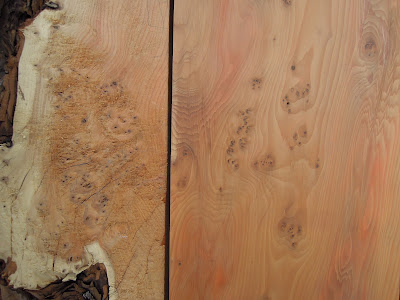1. Letter Box
All credit goes to my girlfriend for this one...'why don't you make a box to hold letters in? they only end up cluttering my nice tidy drawers. Hint.' Good idea.
The oversized frame and panel lid is designed to mimic the look of a letterbox whilst the interior holds a stack of standard business size envelopes. An extra 30mm on the length is allotted for finger space - perfect for digging out buried bills.
All joinery is handcut in the traditional manor. Through dovetails on the box compliment corner bridle joints you see on the lid. I adore working this way.
Bottoms are lined in blue suede to match the interior. Two main benefits come from this; Foremost, protection - not for the box but rather the surface it is to sit upon, no nasty marks left behind. Secondly, friction - the box will stay put when you open the lid.
Said lining on show. There is nothing quite like the feel of close napped suede. The main box elements are constructed from American Black Walnut with a solid American rippled Cherry panel. It has the most fantastic figure, some of the best I have seen on cherry. Each panel was hand thicknessed, a necessity to avoid the machine planer eating it. Om Nom Nom.
This is my own design of box-stay (a device for keeping an open lid poised at 95º). When the lid is closed the phosphor bronze cable glides into a plastic (thus frictionless) sleeve let into the box side. This idea came to me ages ago and took quite a few prototypes before I nailed it. Elegant and simple, it does the job with a minimal feel.
I still have one of these for sale, If you are interested please drop me a line. £220 delivered.
-
2. Drawer Cube
This pair are made in exactly the same way a traditional cabinet drawer would be made. The design is intended to amuse those with a knowledge of fine furniture, even so they went down a treat with the public simply as objects in their own right.
Two features offer this mimicry, the first being differing dovetails, secondly how the bottom is attached. Two grooved components known as 'Slips' are glued to the sides. These hold the bottom in place, secured with a method called 'slot screwing'. This slot allows the timber to expand and contract according to humidity changes without distorting shape of the drawer.
Drawer fronts almost always have 'lapped dovetails' connecting the face. A lap is the thin section you see at the dovetails end. Anyone who has tried to do hand-cut dovetails this fine in solid burr will appreciate the effort involved....worth it? Absolutely. Drawer backs are always jointed with through dovetails (so called because they show through on both sides).
Pivot lids are a simple affair, they swing up on two fine stainless steel pins. Care must be taken when fitting though - if they are skewed even slightly it's glaringly obvious. Note the matched grain.
Lids to attention. Crikey the saturation levels on this photo are outrageous!
My favorite front is the right box, it looks like a bomb went off pushing all the grain outwards. English Yew was used for the back, sides, lid and bottom, the slips are Bog Oak and the fronts Horse Chestnut burr. I find it interesting that although there are thousands of Conker trees all over England, you rarely see it's timber in furniture production. Maybe it's to do with how delicious wood-eating insects find it...
For sale as a matched pair. P.O.A
-
3. Knot-top
My Parents garden has the most fantastic Contorted Hazel tree growing within. As a kid I would stare up, trying to trace the magic branches to find its secret. I did eventually: grafting scion to rootstock, however, this didn't make it any less magical to me.
Every so often my dad sacrifices some branches to the Gods in a ritual known as pruning. I collect the branches, snip off the more useful/interesting sections, boil them, remove the bark and leave to season. For these boxes I wanted a simple understated form to accentuate the Hazels curves.
The effect is quite pleasing. You can make out the heavy chamfer creating a definite visual break between the lid and box.
Once again hand cut Through Dovetails. It's hard to tell from these photos but the bottom dovetail is actually wider than the top - an experiment into perspective: do the two look the same when viewed from anything other than dead on, i.e. from above? The jury is still out on that one, I suspect the overall difference is negligible.
Not just a pretty face - structurally sound to use as a handle. Each Hazel length has flats where it contacts the lid, these were glued with the strongest adhesive available before being secured with tiny brass screws let into the underside.
The Hazel you know about, the sides are made from quarter-sawn American Cherry, the base veneered in American Cherry and the top quarter-sawn Japanese Oak.
A simple oiled finish (three coats oil, two coats wax) sets them off nicely. Note the fine closely spaced growth rings on the lid, typical slow growth induced by Japans climate.
SOLD.
More to come.
N.B. I will be on holiday for the next fortnight, thus uncontactable.






















































